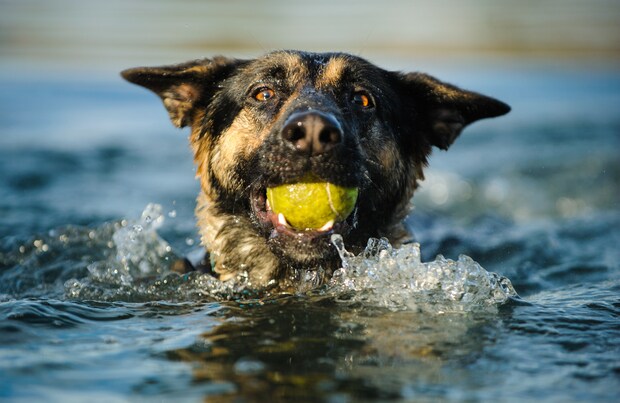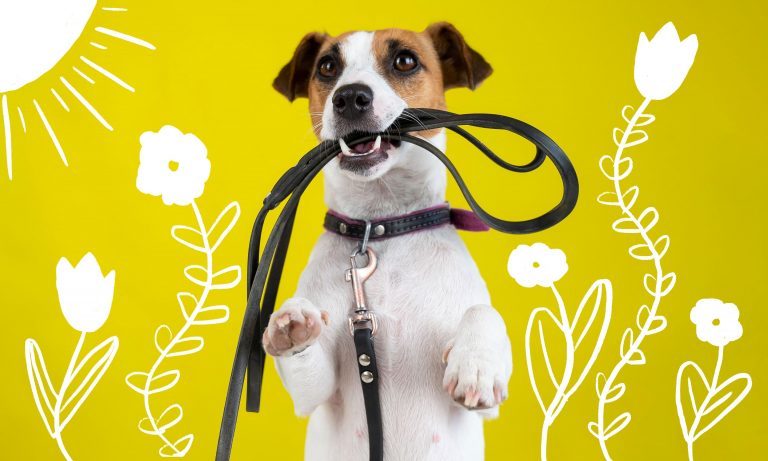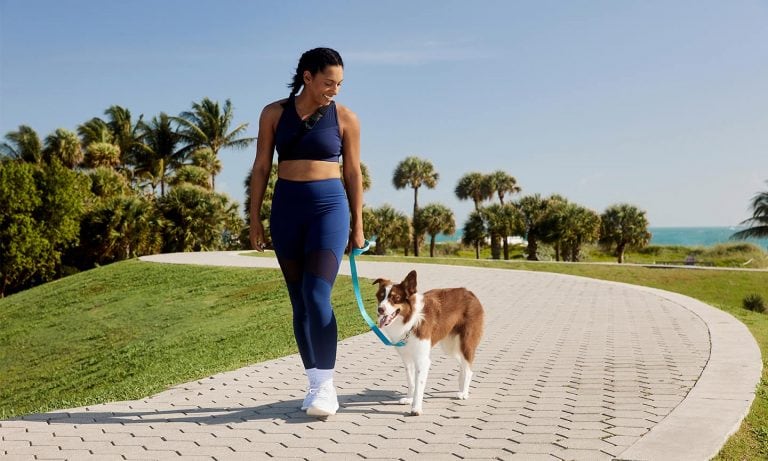Walk or run? Swim or jump? What type of exercise is right for your dog depends on many factors – from his breed to his size to his age. Some breeds love to exercise for hours on end by nature, while others need—and want—a little less.
“High-energy sporting dogs like Vizslas and German Shorthaired Pointers were bred to work very closely with their handlers, and they’re just getting started after an hour-long romp,” says AKC judge, dog expert and owner of Revodana Publishing, Denise Flaim. “On the other hand, though they might look like they need a lot of exercise, hounds like Greyhounds can be happy with a nice neighborhood walk.”
Here are some tips to help you choose the right amount and type of exercise for your dog:
Swimming
Before anything else, let’s get one myth out of the way: It is not true that all dogs can swim.
“People wrongly assume all dogs can naturally swim, but, like humans, that’s not true,” says integrative veterinarian Dr. Carol Osborne, DVM, whose practice focuses on age-related degenerative disease, arthritis and pain management. “Dogs do have a natural instinct to start paddling when they feel themselves in water; this means that the more often you familiarize your dog with being in water the better your dog will do in a situation that requires them to swim.”
Breed is a major factor too. “Some short-legged, dense-bodied breeds, such as Bulldogs and French Bulldogs, simply aren’t buoyant and will literally sink instead of swim,” says Flaim.
Other breeds have the physiques to be swimmers, but not the inclination. “Most Rhodesian Ridgebacks, for example, have to be trained to like water, which makes sense once you remember their origins: In their native Africa, lots of nasty predators can wait under the waterline,” says Flaim.
When in doubt about your dog’s swimming abilities, Flaim says looking to a breed’s original function will give you a good idea whether or not you have a water lover on your hands. “Breeds like Newfoundlands, which were bred for water rescue, and Labrador Retrievers, which were bred to retrieve in water, are genetically wired to love the wet stuff,” Flaim says.
“Dogs do have a natural instinct to start paddling when they feel themselves in water; this means that the more often you familiarize your dog with being in water the better your dog will do in a situation that requires them to swim.”
Even if your dog likes water, swimming might not be the best choice for him. “If you dog has any skin conditions, is recovering from surgery, or has sprained tendons, you should consider holding off on swimming,” Osborne says. “If you have any doubts about whether the water will adversely affect your dog, ask your vet.”
Agility Training
To become an agility superstar, a dog needs two basic characteristics, according to Flaim: he should be from a breed that has a high degree of biddability (the desire to follow their handler’s direction) and he should have a medium-size body type build for speed. “For this reason, Border Collies and Australian Shepherds tend to dominate the winners circle at agility competitions,” says Flaim.
That’s not to say other breeds or mixed breeds can’t be good at agility. According to Flaim, as long as the handler and dog have a good relationship, the dog is motivated to work and — this is often overlooked — the dog is structurally sound enough to take the wear and tear that agility puts on a dog’s body (all that jumping takes its toll), agility training can be done.
Running
If your dog seems to have a never-ending supply of energy, chances are he’ll make a good runner. “Generally speaking, breeds that were bred to do a job in close cooperation with a human tend to have a higher energy level,” says Flaim. This includes many of the sporting breeds (Golden Retrievers, German Short-Haired Pointers, Vizslas and Irish Water Spaniels) and herding breeds (Border Collies, German Shepherds and Malinois).
Because running can be hard on the joints, high-energy dogs can and should be exercised in a variety of ways. “Multiple walks each day, playing Frisbee in the park, going for a hike with your dog are all good ways to help your high-energy pup stay in the best shape possible,” Osborne says.
Easing into Exercise
When it comes to exercise, there’s no doubt that some breeds just weren’t built for it. “For example, brachycephalic breeds — those with ‘pushed in’ faces like Pugs — can overheat very easily,” says Flaim. A breed’s function will also tell you whether your dog would make a good jogging partner. “A Chihuahua or Bulldog was not built for endurance, so they are definitely not candidates for anything more than a nice walk,” Flaim adds.
“Generally speaking, breeds that were bred to do a job in close cooperation with a human tend to have a higher energy level.”
A dog’s size, his health and even the thickness of his coat can also affect how much exercise they can handle. “Many dogs are in fact low energy dogs and are going to be quite content with a short walk and a nice belly rub, including Basset Hounds, Bulldogs, Bull Mastiffs, Chow Chows, Great Danes, French Bulldogs, and Pugs,” says Osborne.
One last thing to keep in mind when choosing the right type of exercise for your dog is age. “Most breeders recommend not running or jogging with your dog on hard pavement until he or she is at least a year old, and up to 18 months old for medium-large to large breeds,” says Flaim. “This is to avoid joint damage in a still-growing dog.”

Diana Bocco is a full-time writer and adventurer, whose work has been published in DiscoveryChannel.com, Yahoo!, & Popular Mechanics.
Share:









